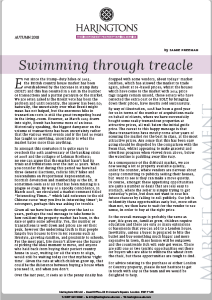 Ever since the Stamp-duty hikes of 2015, the British country house market has been overshadowed by the increase in stamp duty (SDLT) and this has resulted in a fall in the number of transactions and a partial paralysis of the market. We are often asked if the Brexit vote has been the problem and until recently, the answer has been no; naturally, the uncertainty over what Brexit might mean has not helped, but the enormous hike in transaction costs is still the great trumpeting beast in the living-room. However, as March 2019 draws into sight, Brexit has become more of an issue. Historically speaking, the biggest dampener on the volume of transactions has been uncertainty rather that the various world events and if the last 30 years has taught us anything, uncertainty is what the market hates more than anything.
Ever since the Stamp-duty hikes of 2015, the British country house market has been overshadowed by the increase in stamp duty (SDLT) and this has resulted in a fall in the number of transactions and a partial paralysis of the market. We are often asked if the Brexit vote has been the problem and until recently, the answer has been no; naturally, the uncertainty over what Brexit might mean has not helped, but the enormous hike in transaction costs is still the great trumpeting beast in the living-room. However, as March 2019 draws into sight, Brexit has become more of an issue. Historically speaking, the biggest dampener on the volume of transactions has been uncertainty rather that the various world events and if the last 30 years has taught us anything, uncertainty is what the market hates more than anything.
In amongst this confusion it is quite easy to overlook the 10th anniversary of the banking crisis of 2008 and the collapse of Lehman Brothers; no one can argue that the market hasn’t had its trials and tribulations over the last 10 years. When you consider that during this period we have had three General Elections, radical SDLT hikes and referendums on Proportional Representation, Scottish devolution and membership of the EU, it sometimes feels as if all that has been missing is a plague of frogs. By way of a spooky coincidence, in March 2008, we circulated a market comment titled “Interesting Times…” which laid reference to the old Chinese curse ‘may you live in interesting times’; in retrospect, perhaps this was asking for trouble.

Given all we have been through over the last 10 years, perhaps the real message to take home is how resilient the property market has been, in the face of quite some adversity. Yes, the number of transactions is well down and prices are off their peak, however the underlying truth is that people largely buy houses to live in for reasons such as lifestyle, growing families, and proximity to schools. For the most part, life doesn’t allow one the luxury of picking the ideal moment to move, and anyone who held back from buying their perfect country house in 2007, waiting for all the stars to align, would still be waiting today for that mythical ‘right time’. Given the rate at which children grow up, that could be the difference between buying a house when you need it, and when you don’t.
Over the last year, it feels as if the penny finally has dropped with some vendors, about todays’ market realities, which has allowed the market to trade again, albeit at re-based prices; whilst the houses which have come to the market with 2014 price tags largely remain unsold, those sellers who have reflected the extra cost of the SDLT by bringing down their prices, have mostly sold successfully.
By way of illustration, 2018 has been a good year for us in terms of the number of acquisitions made on behalf of clients, where we have successfully bought some really tremendous properties at attractive prices, all well below the initial guide price. The caveat to this happy message is that these transactions have mostly come after years of scouring the market for the best in class, at the most attractive prices. Any sense that this has been easy going should be dispelled by the comparison with the Swan that, whilst appearing to make graceful and effortless progress when viewed from above, below the waterline is paddling away like fury.
As a consequence of the difficult market, we are now seeing a lot of property available quietly, under the counter, where vendors are nervous about openly committing to publicly selling their houses, but want to see if they can make a move quietly. Of course, amongst these appetising opportunities are quite a number of deals that are less easy to stomach, where the seller is simply trying to get yesterday’s price, but does not want to sour his future chances by failing to sell publicly. Our job is to identify these opportunities early but, more often than not, we then have to wait for the vendor to see sense, in order to buy at the right price.
So the overall message is probably the same as ever; life goes on, families grow, children require education and there are only so many extensions or basements that you can add to a London house. Inevitably, unless a buyer is prepared to bite the bullet and buy something much bigger and more expensive in town, these homes will be outgrown and the countryside itch will only get worse. There are still one or two terrific opportunities out there for buyers who are able to winnow the wheat from the chaff, but these opportunities are tough to find. For advice relating to the purchase of either London or Country property, please do not hesitate to get in touch with any of the team and we would be delighted to help.
Jamie Freeman, Director
